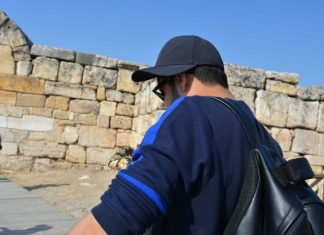No surprise, but such words come in a novel that contrasts the bravery and intelligence of fair-haired northerners with the weakness and treachery of darker-hued southerners. Dahn’s book survived to be made cheaply into a two-part movie, filmed in Romania with German dialogue, in the late i960 s. Justinian was played by Orson Welles; Amalasuntha, daughter of Theoderic and regent of Italy, by Honor Blackman, who had attracted more attention a couple of years earlier in the arms of James Bond in Goldfinger. This faux-Hollywood trifle was the kind of production such unhistorical rubbish deserved. Yet it is extraordinary to note how much modern scholarship has still tended to agree that there must be something to all this racist nonsense.
But surely, a reader might reasonably object, all that smoke about barbarians must point to some fire. There must have been true-blue, ethnically pure tribesmen who followed their leaders ever since they strode, blond and blue-eyed, out of Scandinavia centuries earlier. To get beyond such thinking, look at Mundo, a man of Theoderic’s time in every way, as good a candidate for the description “barbarian” as they came. Mundo was the son of a leader of the Gepids who died young. His uncle Tapstila snatched the leadership away from Mundo, and stood at the head of forces that Theoderic defeated on his way to Italy in 488. When Tapstila was killed in that battle, Mundo’s cousin Traseric succeeded his fallen father and patched together a life in the Balkans serving as one of Theoderic’s tributaries. Around 500, Mundo himself fled his family as he came of age, setting up in business as a leader of fighters (shall we call them bandits, insurgents, mercenaries, or militants?) in what is now Hungary.
Constantinople sent out a general to bring Mundo to heel, but just then Pitzia, one of Theoderic’s generals, advanced toward Sirmium, where he and Mundo joined forces, defeating the intended Byzantine police action at Horreum Margi on the Morava River. Twenty years later, Mundo turned up leading Gepids and Heruls, now accepting a command from Constantinople to fight for empire, against Slavs and Bulgars, in 529. He did so well that he was briefly general in chief of all the Balkans, taking the emperor’s side to put down an incipient revolt in Constantinople itself. Not long afterward, in the mid-530 s, he led Constantinople’s forces to Split, on the eastern shore of the Adriatic, asserting control in a vacuum when Theoderic’s successors were hard pressed just to stay alive in Italy. When Mundo’s son was killed in battle, the father lost both judgment and control and pursued his Gothic opponents so recklessly that they killed him. Mundo lived and died a Roman of his times, whoever his ancestors were private tour bulgaria.
Balkans into Italy
And bear in mind the passage of time. When adult men and women who made their way from the Balkans into Italy with Theoderic saw his last years in the 520s, they also watched their grandchildren come of age, grandchildren who had never known another home. Those grandchildren and their children faced the sudden shock of a nominally Roman invasion in the 530 s and a long war fought to overthrow Theoderic’s heirs and replace them with a puppet regime managed from Constantinople. To place this in perspective, the Goths of the 540s stood at the same remove from the founding moment of Theoderic’s invasion—with a shorter life expectancy and a more rapid perceived change of generations—as the Israelis of today from the kibbutzniks and founders of 1948. Whatever one makes of the politics of the Middle East, the Israelis of today really are Israelis, with no other home and no other culture. Theoderic’s followers, fewer in number proportionally, more assimilated, and more welcomed (even if force made them welcome) than the Zionists of 1948, were if anything more fully at home in that Italian world. They belonged.
The great curiosity of Theoderic’s reign in Italy is not that there were Goths, but that thirty years after his rule began, then (and then only) he began to look to his Gothic roots and tell a Gothic story about himself. Some of this had to do with planning for the succession.
Despite all his successes, Theoderic had one failure; he never had a son. Pious hopes for a successor from his seed appear in occasional texts of the time, but there was none.
Theoderic did have that daughter, Amalasuntha, and she was his opportunity. Having taken effective control of the Visigothic regime in Spain and looking to consolidate his rule throughout the northern coast of the Mediterranean west, he imagined unity by dynasty. Theoderic summoned from Spain a man my Irish ancestors would have called “some kind of cousin,” Eutharic. Once married to Amalasuntha, Eutharic could produce an heir, and did: Athalaric, born in 518. Theoderic, by now well into his sixties, could breathe a sigh of relief. The moment was propitious for celebration, and a celebration was arranged.
Read More about Theoderic appeared in the late 480s








